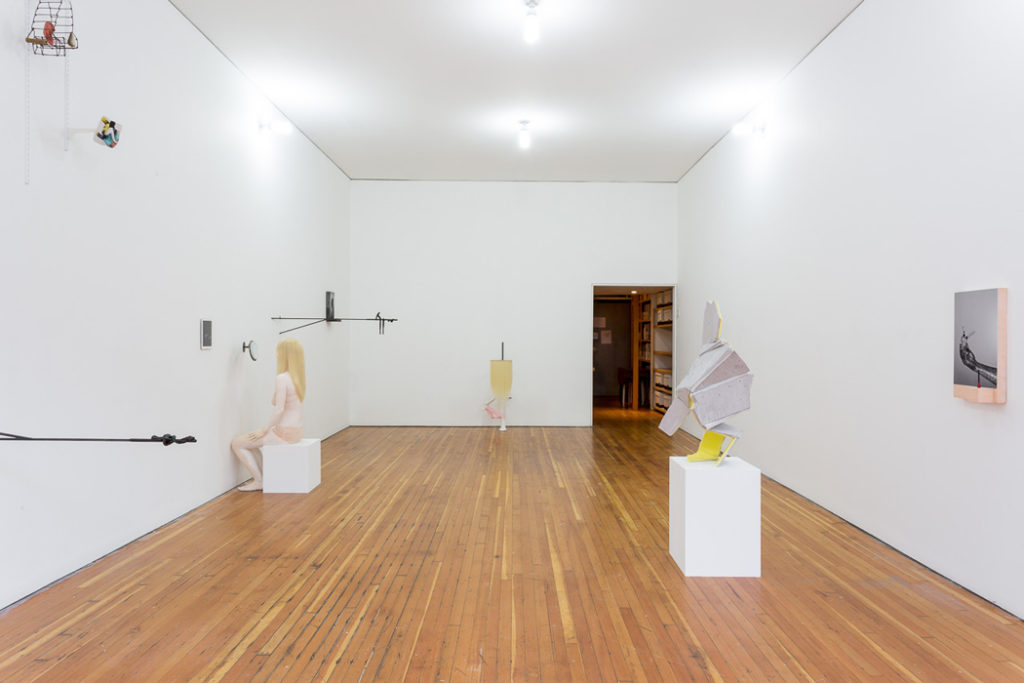My introduction to the work of Montreal artist Valérie Blass came during a studio visit with another artist in the spring of 2012. It was a trying moment as the artist I had come to visit was attempting to solve a support problem for his latest project. But rather than poke my nose in, I made my way towards a messy couch and opened the book whose place I took—what turned out be a catalogue for Blass’s then-current exhibition at the Musée d’art contemporain de Montréal.
What I saw in the first pages of Blass’s catalogue excited me: sculptural assemblages that, in their compositional fluidity and narrative complexity, recalled a range of artists whose works were on my mind at that time: senior artists like John Stezaker, and another Montrealer, David Altmejd, as well as Vancouverites Elizabeth Zvonar and, now nodding knowingly at me from behind a section of his dOCUMENTA (13)–bound installation, Geoffrey Farmer.
Although I had an opportunity to meet Blass during a private power-point presentation in Vancouver two years later, it was not until her most recent exhibition at the boutique-sized Artspeak—the first exhibition of her work in Vancouver—that I was able to experience her compositions first-hand.
Of the 11 works in “Valérie Blass: My Life,” three are entitled Vices, and they are spaced to form a scalene triangle. The first (subtitled pavaner, or “strut” in English) is the first work you see and is positioned within a V-shaped pocket where the gallery’s south wall meets its eastern glass face. While this Vices features an image of a gloved hand, its fingers curled around a curvaceous abstract object, the second Vices (épater, or “wow”) has as its held object (with two gloved hands) a glass bong. Attached to the support below the image is a small cube, atop which is a cigarette holder. The third Vices at the far end of the south wall (pontifier, or “pontificate”) marks the return of a single gloved hand, this time offering up a liquor flask. Within this uneven triangulation lies the remainder of the exhibition—with one exception, which I will get to later.
Of the seven works within the triangle, each is in some way related to another, be that materially, narratively or, in some instances, both.
Moving west on the south wall, the work that follows the first Vices, entitled La mépris (or “The contempt”), has a three-dimensional black cartoonish head facing a concave mirror. Because of its position, we cannot help but see the mirror first, in which case we see what appears to be a proportioned face. However, in adjusting ourselves to see what the mirror is “seeing,” we see an unbearably outsized nose. Three works down the wall is another piece, entitled Dr. Mabuse, psychoanalyste, where the face in the mirror is equally proportioned to the life-sized female form seated before it—until we once again adjust our view and find that the face is impossibly smaller than the head to which it is attached.
Other pairings within the triangle include two small steel sculptures—Sois gentille (“Be nice”), and, three works down the south wall, its masculine complement, Sois gentile—where small discombobulated figures balance their parts on miniature steel girders; as well, a free-standing sculptural work, entitled Surtout ne pas consulter les ingenieurs! (“Especially do not consult engineers!”), that re-appears, as it were, as an animated kicking subject on an iPad on the wall to the left of Mabuse.
The final work in the exhibition, the one outside the triangle, is Je suis une image (“I am an image”). Although this work has no direct relationship to any of the other single works in the exhibition, it is not unrelated to everything that comes before it: a figure based more on gesture (a waterfall of hair before a pair of panties stretched between a hand and an ankle) than a physically perfected form; a free-standing sculpture that, like those discombobulated “be nice” feminine and masculine figures on miniature steel girders, is in fact “engineered” to the wall.









